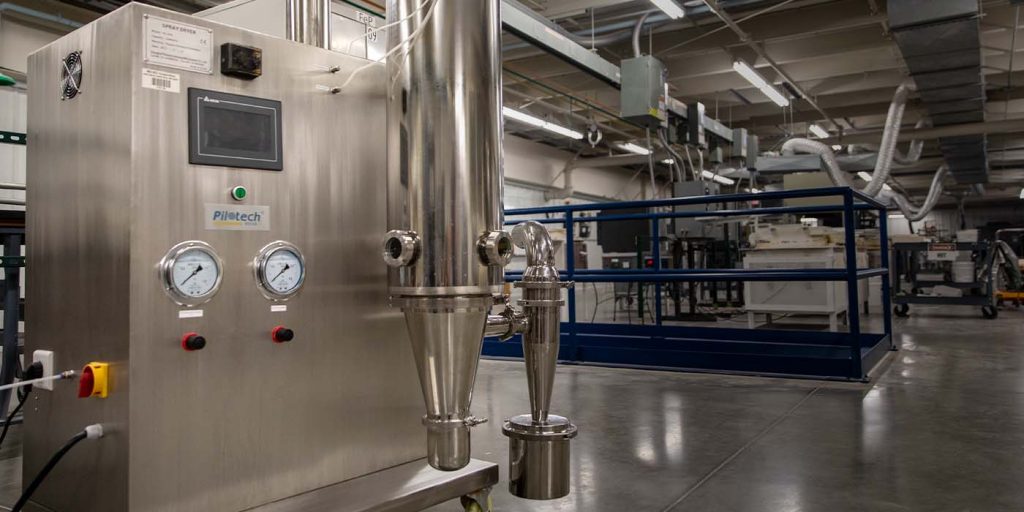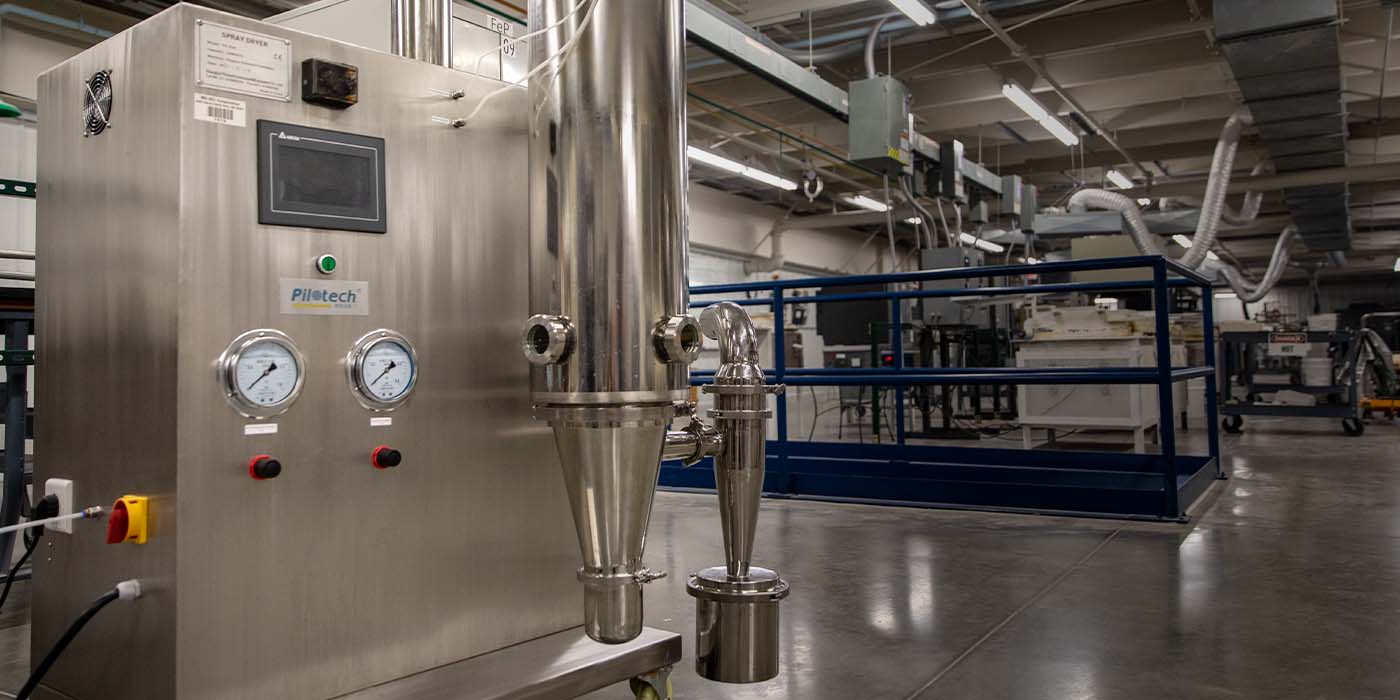
Spray drying is a technique used to produce dry powders from liquid slurry through a rapid drying process. Often, the liquid is sprayed with hot gas to further accelerate the drying stage, making it highly time-efficient. Spray drying is used by many industries for the production of powders from a diverse range of starting materials, including biological matter, foods, and glass powders.1,2
Spray drying technologies can be used simply for producing dust-free powders but they can also be used as part of the particle manufacturing process. For high-performance materials such as ceramics, producing granular powders by spray drying methods may have beneficial effects on the physical properties of the final material.2 This is, in part, because spray drying allows excellent selectivity for particle sizes that can be controlled by varying conditions, such as the temperature, pressure, and nozzle dimensions.
The spray drying process involves several steps. First, the sample is atomized to form a liquid droplet containing the chemical species of interest. The solvent is then rapidly evaporated, usually with heated air, to remove the excess solvent and form a particle. If multiple chemical species are present, this can be a composite particle. There are numerous atomizer designs, from air-shear nozzles to spinning disks, as well as ultrasonic nebulizers which can be tailored to the process of interest.
Applications of Spray Drying
There are various applications for spray drying, including pharmaceutical manufacture, production of dried milk powders, and the creation of ceramics for dentistry. For glass powder production, spray drying is a desirable method not just for its rapid drying capabilities but also for its ability to produce very spherical particles of narrow size distributions.
Alternative methods for glass powder production — for example, the family of glass milling techniques including ball milling or hammer milling, do not necessarily have the same level of precise control, particularly for the production of particulates with dimensions on the order of microns.
For biomedical applications, the level of control spray drying offers over the physical properties of the particles is highly desirable. Manufacturing processes in this area must pass stringent quality and reproducibility checks, and products must be reliable at both the microscopic and macroscopic levels.
Spray drying is compatible with a variety of chemical solvents, including aqueous solutions, making it a diverse and flexible technique for many different systems. Spray drying has become popular for glass powder production due to its ability to create small particles. As the particle size is proportional to the concentration of the chemical feedstock,4 this can be controlled to limit the number of large particles formed. The different behavior of particles of different sizes also makes for easier separation based on size.
While spray drying is excellent at selecting given particles sizes and providing homogenous size distributions, it can also be used to create aggregates. For example, for the creation of dental materials, spray drying has been used to aggregate 5 µm particles into loosely agglomerated particles of a ~ 25 µm diameter.5 In this application, changing the powder to liquid ratio affected the rate at which fluoride was released. This helped create material for dental implants, which would help prevent further cavities.
The advantages of homogenous size distributions can be seen in the making of sealing glasses as well. Sealing glasses are used for bonding and setting components and can be supplied in several forms, including pastes, tapes, and preforms. Creating preform involves pressing the glass powder in a mold and firing it. This type of manufacture has very stringent requirements on the properties of the glass powder used, including good flow without clumping, which spray drying can help to achieve.
As part of making preform glasses through spray drying, organic binders are often added to the liquid slurry before spraying. The organic binders help the particles to hold together more strongly and form agglomerates, which enhances the adhesive effects of the final preform. This also ensures they flow well into molds and will set in the correct shape.
Mo-Sci’s Glass Processing Services
Mo-Sci produces a variety of specialty glass powders from unique formulations that are difficult to find elsewhere.6 Our class VI spacer grade glass microspheres are produced to provide highly accurate spacing and are available in size ranges from 38 µm ± 7% to 850 µm ± 5%.
We also offer an extensive range of bioactive glasses and other biomaterials, many of which are spray-dried powders. To maintain the rigorous safety standards required for biomedical devices, all of these materials are produced in environmentally controlled spaces and with very high purity ceramic or precious metal equipment to avoid any risk of contamination.
Contact us today to find out how our custom processing capabilities could boost the performance of your glass powders using advanced manufacturing techniques.
References
- Shishir, M. R. I., & Chen, W. (2017). Trends of spray drying: A critical review on drying of fruit and vegetable juices. Trends in Food Science and Technology, 65, 49–67. https://doi.org/10.1016/j.tifs.2017.05.006
- Arpagaus, C., Collenberg, A., & Rütti, D. (2019). Laboratory spray drying of materials for batteries, lasers, and bioceramics. Drying Technology, 37(4), 426–434. https://doi.org/10.1080/07373937.2017.1410487
- Cattell, M. J., Patzig, C., Bissasu, S., Tsoutsos, A., & Karpukhina, N. (2020). Nucleation efficacy and flexural strength of novel leucite glass-ceramics. Dental Materials, 36(5), 592–602. https://doi.org/10.1016/j.dental.2020.03.017
- Nandiyanto, A. B. D., & Okuyama, K. (2011). Progress in developing spray-drying methods for the production of controlled morphology particles: From the nanometer to submicrometer size ranges. Advanced Powder Technology, 22(1), 1–19. https://doi.org/10.1016/j.apt.2010.09.011
- Panpisut, P., Monmaturapoj, N., Srion, A., Angkananuwat, C., Krajangta, N., & Panthumvanit, P. (2020). The effect of powder to liquid ratio on physical properties and fluoride release of glass ionomer cements containing pre-reacted spherical glass fillers. Dental Materials Journal, 39(4), 563–570. https://doi.org/10.4012/dmj.2019-097
- Mo-Sci (2021) Glass Milling, https://mo-sci.com/glass-milling-equipment-techniques/, accessed 10th September 2021

